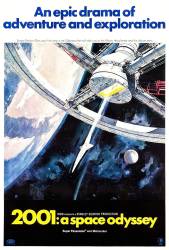Revealing mistake: When we see the space station from the cockpit of the approaching shuttle, the station does not appear to rotate because the shuttle is rotating at the same speed. OK...except that the station IS still rotating with respect to the sun, which means that the light source and shadows on the station should be moving.
Revealing mistake: During the "Dawn of Man" sequence, the ape-man scenes were shot on an indoor stage with projected background images on a huge screen behind the stage. The screen itself was a highly reflective cloth. In most shots, it is quite convincing, but in several (especially when facing the aggressive, victorious group during the first fight, then again when facing the tool-using group in the last fight), the rear screen appears to be a patchwork of smaller pieces of cloth as very obvious puzzle-like shapes of varying reflectivity appear in the sky. Once you notice them, it's incredibly distracting. It was originally parallel strips, but they were VERY visible as vertical lines so they were torn into a patchwork to make lines less obvious. (00:08:35 - 00:18:00)
Revealing mistake: When the astronauts are on the way to the monolith on the Moon, there are two windows seen within the interior of the small space shuttle. During their small lunch, in the left window, the horizon is seen as the surface of the Moon is flowing back against the direction of the flight. However, although sometimes this horizon fills up to half of the window, no horizon can be seen in the right window despite being located directly beside the left window. Nevertheless, the inclination of the Lunar surface should allow for it to be seen.
Revealing mistake: When Dave Bowman is attempting to break into the Discovery after being locked out by Hal you can see, reflected in the Pod window as the Pod is spinning around, the edges and top corner of the small set of the Discovery hatch area. (Second timecode is accurate for DVD release) (01:43:00 - 01:46:50)
Revealing mistake: In the sequence of the shuttle approaching the moon the pilot talks to Dr. Floyd. Floyds food-tray moves away from his knees because of the zero gravity in the shuttle. But it doesn't drift straight away, it swings like a pendulum showing that the tray is hanging on a string.
Revealing mistake: When the lead ape-man is attacking and beating the rival ape-man group leader with a pig bone, the bone bends with each blow, revealing that it was made of rubber.
Revealing mistake: The classic scenes of ships in earth orbit is quite realistic, but the Earth lacks an atmosphere. Examining actual photos shows a soft glow around the edge of the earth, missing in the film.
Revealing mistake: When Dr. Floyd arrives at the Moon and goes to the Monolith site at Tycho Crater, the moon shuttle never casts a shadow on the lunar surface. This is especially noticeable in the first shot, wherein the shuttle is coming straight at the camera, the Sun is on the far right, and there is a giant lunar cliff on the far left. No shadow of any sort.
Revealing mistake: When Dave Bowman attempts to re-enter Discovery One via the emergency airlock after blowing the explosive bolts on the pod door, where does said pod door go? And also, because of Newton's law of motion, the sudden rush of cabin air during decompression inside said pod after the bolts had blown the door off would have resulted in the pod being pushed in the opposite direction (in effect, that rapid escaping air would have acted like a rocket motor, propelling the pod like a cannonball from a gun!).
Suggested correction: Did you watch the film? The pod bay door doesn't come into it. Bowman enters via the emergency entrance, not a pod bay. The door of the pod and the door of the emergency exit slide sideways into cavities that are there for that purpose - hinged doors don't make any sense in a cramped spacecraft. We see the emergency entrance doorway slide back into position when Bowman activates it.
I think you confused the pod bay door with the door on the pod itself. In the explosive bolt sequence, the pod door does disappear. There is an expanding cloud from the pod door, but no flying door or evidence of it in the emergency airlock. Just an open hole in the pod.
In the scene just before HAL reads the astronauts' lips in the pod, we see that the pod door does slide sideways into the pod hull. The explosive bolts, marked by small red patches, are located in a pattern all around the edge of the door. This indicates that the explosive bolts would blow that section of the door outward rather than sideways into the hull storage pocket.
Bowman programmes the bolts on one side of the door only to detonate, blowing it sideways.
Sure, that might work, but how about this? Bowman knows that the door is constructed of a special composite material that instantly vaporises if it is compressed in just the right way. So, he reprograms the charges to set up a harmonic series of shock wave fronts that destabilises the composite of the door structure, tuning it into the large cloud of smoke we see in the scene.





